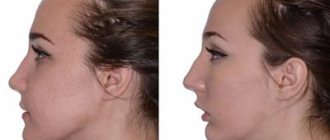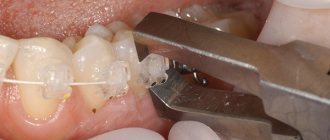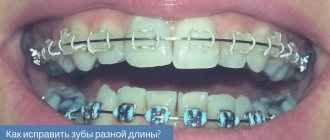Quick transition Treatment of a short frenulum of the tongue
A short frenulum of the tongue (ankyloglossia) is one of the most common minor anomalies in the development of the oral cavity.
The frenulum of the tongue is a fold of the oral mucosa that runs along the midline and connects the floor of the mouth with the lower surface of the tongue.
The function of the tongue frenulum is to fix the tongue to the soft tissues of the oral cavity, preventing tongue retraction (glossoptosis), especially during the neonatal period.
Symptoms
When crying, the tip of the baby's tongue bifurcates in the shape of a stylized heart.
The baby cannot stick his tongue out of his mouth. To test this reflex, you can run your finger over the baby's lips. Normally, the baby sticks his tongue out quite far, moving it around his lips in search of mother's milk.
Breastfeeding takes a lot of time, the baby is capricious, nervous, and clicking sounds are heard when sucking.
The baby is not gaining weight well.
A child with a short frenulum cannot reach the palate with his tongue.
There is a noticeable disturbance in the pronunciation of certain sounds during speech formation.
With a short frenulum (less than 1.5 cm), if it is attached to the soft tissues of the floor of the mouth, functional disorders do not always occur. These include difficulty sucking during breastfeeding and disturbances in sound pronunciation during the formation of phrasal speech.
Causes
Due to the fact that the causes of glossitis have not been identified for certain, it would be more correct to talk about risk groups of patients who are more susceptible to developing this disease. The following can be considered as provoking factors that can cause the onset of the disease:
- Disturbances in the normal functioning of the gastrointestinal tract.
- Diseases of the circulatory system.
- Disorders of the nervous system.
- Hormonal imbalances.
- Weakened immunity.
- Pregnancy.
- Acute infectious diseases.
- Avitaminosis.
- Dysbacteriosis, including those caused by long-term use of antibiotics.
- Heredity.
Desquamative glossitis is a chronic disease. It is absolutely not contagious. In about half of the cases it develops together with a folded tongue and glossalgia.
Consequences of frenulum anomaly
Hypotrophy due to impaired sucking, poor weight gain in infants.
Malocclusion, the first signs of which during the period of temporary occlusion is the rotation of the central lower incisors to the lingual side.
Impaired development of the lower jaw, as a result, the formation of a distal bite.
Local gingivitis, periodontitis up to exposure of the roots of the teeth in the area of the lower jaw incisors.
Violation of the pronunciation of sounds that require raising the tongue upward: “sh”, “zh”, “sch”.
Impaired language development due to asymmetrical growth. Low mobility of the tongue impairs the articulation of some sounds. Violation of diction (clarity, intelligibility of pronunciation).
Diagnostics
Making a correct diagnosis is not particularly difficult, so any doctor can recognize the geographic language based on the following studies:
- Collection of anamnesis, which is based on the patient’s complaints and examination data.
- General analysis .
- Bacteriological culture to detect pathogenic microorganisms and determine the causative agent of the disease.
- Polymerase chain reaction (determination of the pathogen by DNA).
- Enzyme immunoassay (presence of non-standard antibodies).
- Scraping the mucous membrane of the tongue to identify treponema pallidum (if syphilis is suspected).
- analysis to detect worms.
To differentiate from other diseases, the doctor focuses more on the movement of lesions.
Signs and methods of treating tongue diseases
The action of external and internal factors individually or in combination causes various pathologies, among which the most common are infectious, congenital and chronic glossitis, leukoplakia, as well as a symptom complex called glossalgia.
Infectious glossitis
Infectious diseases of the tongue can be recognized by photos and descriptions, but only a doctor can make an accurate diagnosis.
| Name of the disease | Pathogen | Symptoms | Treatment |
| Candidiasis (thrush) | Fungal infection – Candida albicans | White coating with a cheesy consistency, as in the photo. Removing plaque is accompanied by pain and bleeding. Children often have fever. | Lubricating the inflamed areas with antifungal ointments, rinsing with soda solution, Furacilin or manganese. |
| Herpetic glossitis | Herpetic viral infection – Herpes simplex virus | Rashes in the form of small watery blisters, as in the photo. If they open, erosions appear on the tongue. The rash is painful and accompanied by fever. | Taking antiviral drugs orally, lubricating the rash with antiviral ointments, rinsing the mouth with Chlorhexidine. |
| Streptococcal impetigo | Bacterial infection – streptococci | The tongue becomes inflamed, red spots appear, in place of which bubbles up to 1 cm in diameter develop, as in the photograph. When the blisters open, ulcers form. | Taking antibiotics orally and in the form of ointments, rinsing the mouth with Furacilin, soda or manganese solution, Chlorhexidine, chamomile decoction. |
Additionally, symptoms accompanying the inflammatory process are treated: for fever, an antipyretic is used, for unbearable pain, analgesics are used, and more fluids should be drunk to prevent dehydration. Regular oral hygiene helps eliminate infections and ulcers on the surface of the tongue.
Catarrhal and ulcerative glossitis
Catarrhal and ulcerative glossitis are also infectious diseases of the tongue, the symptoms and treatment methods of which are similar to the infectious diseases described above. But the cause most often lies not in infection of the epithelium of the oral cavity itself, but in the complication of general infectious processes (ARVI, influenza) or inflammation of the gastrointestinal tract. This diagnosis is often found in smokers and people who abuse alcohol.
With the catarrhal form of glossitis, taste perception changes, pain appears, and tingling occurs. Inflammation causes swelling, which leaves teeth marks on the sides of the tongue. A dense layer of white plaque accumulates on the root of the tongue.
If left untreated, catarrhal glossitis turns into an ulcerative form with the formation of bleeding ulcers
, covered with a layer of dead epithelium, and the appearance of an unpleasant odor.
In case of catarrhal and ulcerative forms of glossitis, it is necessary to treat both the general disease, which entails pathological changes in the tongue, and external manifestations (erosions). May be assigned:
- Antiviral and immunomodulatory drugs by mouth.
- Rinsing the mouth with antiseptics and herbal decoctions to eliminate inflammation and heal ulcers that have affected the human tongue. You can use chamomile.
- If plaque accumulates, wipe it off with clean gauze.
Desquamative glossitis
In diseases of the digestive organs and metabolic disorders, diathesis, dysbacteriosis, inflammation of the tongue may be accompanied by a change in the location of the grooves and thickening or desquamation of the papillae. Subsequently, pink and red spots appear on the surface, clearly delimited by whitish ridges. This set of symptoms is called “geographical tongue.”
To eliminate the pathology, it is necessary to treat the disease that led to such changes. Depending on the cause of the pathology, the patient is prescribed different groups of drugs:
- Antiallergic.
- Vitamin.
- Anti-inflammatory.
- Probiotics to eliminate dysbiosis.
For local treatment of a sore tongue, rinsing with antiseptics and lubricating the mucous membrane with a vitamin A preparation are used.
Congenital abnormalities of the tongue
Rhomboid glossitis is caused by congenital features of muscle development. It appears as a growth on the back of the tongue (near the root) up to 10 mm in length, characterized by a glossy surface of bright red color.
Folded glossitis is characterized by congenital uncharacteristic folds on the tongue, although the mucous membrane is of normal color. In the absence of other diseases, this feature does not cause discomfort, but metabolic disorders and vitamin deficiencies can provoke keratinization and cracking of the surface of the folds.
Treatment may include the following:
- If such diseases are complicated by infection or cracking of the tongue, it is necessary to treat the oral cavity with antiseptics.
- For vitamin deficiencies, a special diet and taking vitamins in the form of medications are indicated.
- For rhomboid glossitis, cryotherapy is used. To avoid complications, patients with such problems are not recommended to smoke.
Hairy black tongue
The name of this tongue disease is explained by its photo and description of the symptoms. The tongue does look hairy, but this effect occurs due to the pathological growth of papillae on its back closer to the root. They can reach 2 centimeters in length. Gradually these structures die off and turn black.
The cause of this pathology is metabolic disorders or taking medications harmful to the body. Tobacco smoke and alcohol, which affect the body for many years, can provoke the growth and death of papillae. Doctors admit that the disease may be caused by genetic mutations.
This disease is treated with antiseptic drugs to wash away plaque and keratolytic agents. Papillae that become inflamed and die can be removed using cryodestruction. You need to follow a gentle diet, stop smoking and spicy irritating foods.
Leukoplakia
This tongue disease most often occurs in men in adulthood and is usually associated with metabolic problems or diseases of the digestive system. Leukoplakia does not cause pain, but the patient may feel discomfort when eating spicy foods. Symptoms of this tongue disease can be seen in the photo on the right. The mucous membrane of the organ becomes covered with whitish plaques, which spread to other parts of the oral cavity and may appear in the corners of the mouth. After a few weeks, the affected epithelium thickens.
Treatment of the causative disease is necessary. The affected areas of the tongue are cleaned with:
- Laser therapy.
- Radio waves
- Electroexcision method.
- Diathermocoagulation method.
If the doctor suspects the cells have degenerated into malignant ones, surgical treatment will be performed.
Glossalgia
This problem with the tongue is caused by frequent injuries in the mouth or serious disturbances in the functioning of internal organs; the pathology most often affects elderly patients. Glossalgia is not a separate disease, it is a complex of symptoms characteristic of certain diseases.
With glossalgia there are practically no visible external signs - redness or the appearance of ulcers. Only in some severe cases there is a grayish coating. The manifestation of the pathology is felt by the sick person himself: the tongue becomes painful in one place, or the pain spreads throughout the entire muscle. Due to dry mucous membranes, severe itching or tingling occurs, and the discomfort usually increases with excitement.
Sometimes the pain syndrome disappears on its own, but it is unacceptable to ignore such signs of the disease without attention and accurate diagnosis. The dentist must carry out a complete sanitation of the mouth, check the condition of the dentures, if any, as they can cause permanent injury. When an internal disease is detected, the detected problem must be treated. If the tongue hurts very badly, the discomfort is eliminated with the help of analgesics.
The oral cavity can be exposed to various harmful influences, therefore, to prevent tongue diseases in humans and eliminate their symptoms, comprehensive health care is necessary. If signs of illness appear, you should consult a doctor and carefully follow his instructions. In order not to miss the initial stages of pathologies, you need to carefully look at the surface of the tongue in the mirror from time to time.
Prevention
To prevent the development of such a disease, you need to follow some simple preventive rules:
- Promptly treat all diseases that provoke the development of pathology.
- Do not abuse alcoholic beverages, tobacco products, sweet foods and sugar, and strong coffee.
- Take enough vitamins to avoid vitamin deficiency.
- Perform hygiene .
- Treat caries in a timely manner.
There are separate preventive measures for children:
Caring for baby teeth – timely treatment and removal of baby teeth. If a child complains of dry mouth, rinse with herbs such as sage, St. John's wort or chamomile.
Brushing your teeth should be done only with toothpastes, since the powders contain mint oil and menthol, which are bad for the oral mucosa in children.









